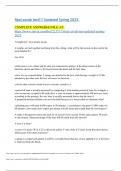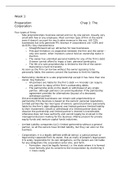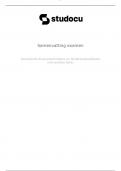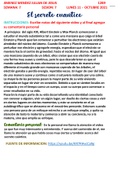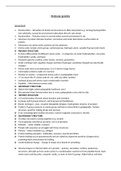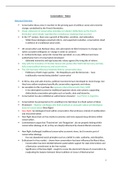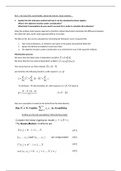CHAPTER 7 (CONSTITUTIONAL PROTECTION OF PROPERTY)
Section 25 of the Constitution regulates constitutional property interest
S25(1) states that no person may be deprived of property except in terms of law of general application
S25(2) states that property can be expropriated in regards of the above for public purpose/interest and
subject to compensation which must be agreed by those impacted or by the court
CHAPTER 8 (STATUTORY LIABILITY FOR PROPERTY HARMS)
Companies are juristic persons, and they exist in their own right and have legal identity from the people
running it and investing into it and they have separate legal personality
Directors of a company owe various legal duties to the company to ensure that it is managed effectively
Section 77 of the Companies Act is quite intricate, focus will be on section 77(2)(b)
Section 77(2)(b) states that the basic conditions triggering liability is when we have a director that causes
harm to a company’s financial position by breaching one or more duties stipulated in section 76(3)(c)
Section 76(3)(c) talks about the degree of care, skill and diligence that is expected from directors
carrying out their responsibilities
CHAPTER 9 (AFRICAN CUSTOMARY LAW ON PROPERY HARMS)
Customary law is casuistic as it is focused on restoration and not monetary compensation
Applicable in certain circumstances (adjudicative subsidiarity) and holds same weight as common law
When an animal is killed the wrongdoer must provide a similar animal and keep the carcass of the dead
animal
A supplementary rule is that the owner must control their animals (grazing animals) and there is no
liability when there is an accident by a docile animal (previously) but liability for domestic ones
Animal harm caused by another animal owner of harming causing animal must compensate
Animal harms crops owner must compensate
Animal harms a person animal is killed, and compensation may occur or not
For stock theft, the procedure is spoor law; animal is killed; liability for x2 value of animal (delict); liable
for additional amount (criminal fine)
For any other stolen property, the offender is liable for x2 the value of the stolen property
CHAPTER 10 (AQUILIAN LIABILITY: HARM)
Aquilian liability has its roots in actio legis Aquiliae originating from lex Aquilia
5 elements of delictual liability are harm; conduct; fault; wrongfulness; and causation
Defining Patrimonial Harm & Cases
In Warneke, it was stated to claim under lex Aquilia, there should be actual damnum in the sense of loss
to property of the injured person (compensation was only for patrimonial losses)
In other words, the reduction of the victim’s patrimony through the infringement of financial
interest/right that led to a negative financial consequence
Patrimonial harm is subdivided into physical harm to tangible property (crashing a car); physical harm to
victim’s body (loss of earning capacity/income); pure economic loss (financial harm not resulting from
physical harm)
In Warneke, it deals with whether a person can have right/legitimate legal interest in something
In Dhlamini, we see that the court makes a distinction between 3 scenarios of illegal income
Illegal and criminal no right to income
Illegal but not criminal (there is a public interest) no right to income
Illegal but not criminal (no public interest) may have a right to income
In Mervyn Dendy I, reiterated the fact that the breadwinner can only claim if he is in the 3 rd category
In Mervyn Dendy II, breadwinner can claim for loss of earning capacity), however for illegal income only
when the breadwinner dies may dependents claim for loss of support (compensation is done on a case-
to-case basis)
In Mervyn Dendy III, you are able to claim for loss of earning capacity (even illegal activities) and you
cannot punish dependents for the sin of breadwinner. Right of support requires compensation even for
illegal income activities (compensated as if they were gaining legal income)
Loss of income relates to past and future income that you have a legal right to
Loss of earning capacity relates to using your capacity to earn a legal income in a property-like interest
CHAPTER 11 (AQUILIAN LIABILITY: CONDUCT)
Positive conduct: commissions or acts and involves actively doing something (e.g., throw, drive, open)
Negative conduct: omissions or failure to act (e.g., doing nothing, failing to maintain)
The type of conduct will impact the element of wrongfulness
Requirements For the Element of Conduct
1
, There are 2 requirements for conduct to be regarded as legally relevant in delict
The conduct must be executed by a human being (owners will be held liable for their animals)
The conduct must be voluntary (voluntariness refers to a person’s physical ability to control their
body and this could be a sleepwalker that causes harm)
Sane automatism is the main defence in negating voluntariness
In Molefe v Maheng, we need to look at the evidence and how it supports the respondent’s version
(medical evidence is required), burden of proof rested on the respondent
In Government v Marine and Trade Insurance reiterates the burden of proof above
In S v Van Zyl, where automatism is raised, the onus of proof depends on whether the accused’s state of
mind is due to mental illness (if not, state is required to prove voluntariness)
Victims can raise antecedent liability (knew of condition and did not follow correct procedures) in
replication to wrongdoer’s defence of automatism
In Wessels v Hall & Pickles, reiterates that we must see if they used reasonable care
Another defence from criminal law that excludes voluntariness is absolute force (vis absoluta)
CHAPTER 12 (AQUILIAN LIABLITY: FAULT)
There is a two-step enquiry that needs to be followed for fault
Firstly, is there capacity for fault and to have capacity you need to be able to distinguish between
what is right and wrong and act in accordance with that appreciation
Secondly, fault must be established, in the form of dolus (intention) or culpa (negligence)
In Weber v Santam, it states that capacity involves the psychological abilities of an actor which reiterates
what has been said in the first step of the enquiry above
SA case law says that capacity for fault is influenced by a person’s age, mental health, and intoxication
Age
Age Group Common Law Capacity (Midgeley)
Infants (7) - Van Oudtshoorn, court agreed that there is no capacity
Pre-teens (7-14) - Hendricks; Jones, kids are presumed to lack capacity unless otherwise stated
- Weber, do not place an old head on young shoulders
Teenagers (14) - Treated the same as adults
Age Group Statutory Capacity – Child Justice Act (Neethling and Potgieter)
Infants (10) - Section 7 an infant does not have criminal capacity and must be dealt with by s9
Pre-teens (10-14) - Section 7 at this age a child is presumed to lack criminal capacity unless it can be
proven that they do according to s11
Teenagers (14) - Considered as adults and the judge must deal with each case on its own merit
Mental Health
Psychological disability is seen as mental illness (can escape liability lacked capacity for fault)
In S v Eadie, we see that a person filled with rage cannot claim they lacked criminal capacity as the law
requires us to control our anger
Intoxication
In S v Chretien, we see the use of the word “papdronk” which means to lie drunk on the floor, virtually
passed out, your body is making short contracting movements voluntarily (matter of automatism)
Actio in libera causa the wrongdoer got himself into the state of automatism on purpose
(criminal law equivalent of antecedent liability as a replication to the defence of automatism)
May be sober enough to act voluntarily but drunk enough to lack cognition and conation
(capacity)
Criminal Law Amendment Act, s(1) states that acts committed under the influence is punishable in
accordance with the act buy may lack criminal capacity
Intention
Dolus directus The wrongdoer directed their will to achieve a specific consequence and acted in a
manner to realise this consequence
Dolus indirectus The wrongdoer has a primary consequence in mind. However, to achieve this
primary consequence, the wrongdoer realizes that another unavoidable consequence will have to occur
and continues with their conduct in achieving the primary consequence
Dolus eventualis Wrongdoer has a primary consequence in mind, however, to achieve this primary
consequence, the wrongdoer subjectively foresees the possibility that another consequence may occur.
Wrongdoer reconciles themself with this possibility and carries out conduct in achieving primary purpose
2
Section 25 of the Constitution regulates constitutional property interest
S25(1) states that no person may be deprived of property except in terms of law of general application
S25(2) states that property can be expropriated in regards of the above for public purpose/interest and
subject to compensation which must be agreed by those impacted or by the court
CHAPTER 8 (STATUTORY LIABILITY FOR PROPERTY HARMS)
Companies are juristic persons, and they exist in their own right and have legal identity from the people
running it and investing into it and they have separate legal personality
Directors of a company owe various legal duties to the company to ensure that it is managed effectively
Section 77 of the Companies Act is quite intricate, focus will be on section 77(2)(b)
Section 77(2)(b) states that the basic conditions triggering liability is when we have a director that causes
harm to a company’s financial position by breaching one or more duties stipulated in section 76(3)(c)
Section 76(3)(c) talks about the degree of care, skill and diligence that is expected from directors
carrying out their responsibilities
CHAPTER 9 (AFRICAN CUSTOMARY LAW ON PROPERY HARMS)
Customary law is casuistic as it is focused on restoration and not monetary compensation
Applicable in certain circumstances (adjudicative subsidiarity) and holds same weight as common law
When an animal is killed the wrongdoer must provide a similar animal and keep the carcass of the dead
animal
A supplementary rule is that the owner must control their animals (grazing animals) and there is no
liability when there is an accident by a docile animal (previously) but liability for domestic ones
Animal harm caused by another animal owner of harming causing animal must compensate
Animal harms crops owner must compensate
Animal harms a person animal is killed, and compensation may occur or not
For stock theft, the procedure is spoor law; animal is killed; liability for x2 value of animal (delict); liable
for additional amount (criminal fine)
For any other stolen property, the offender is liable for x2 the value of the stolen property
CHAPTER 10 (AQUILIAN LIABILITY: HARM)
Aquilian liability has its roots in actio legis Aquiliae originating from lex Aquilia
5 elements of delictual liability are harm; conduct; fault; wrongfulness; and causation
Defining Patrimonial Harm & Cases
In Warneke, it was stated to claim under lex Aquilia, there should be actual damnum in the sense of loss
to property of the injured person (compensation was only for patrimonial losses)
In other words, the reduction of the victim’s patrimony through the infringement of financial
interest/right that led to a negative financial consequence
Patrimonial harm is subdivided into physical harm to tangible property (crashing a car); physical harm to
victim’s body (loss of earning capacity/income); pure economic loss (financial harm not resulting from
physical harm)
In Warneke, it deals with whether a person can have right/legitimate legal interest in something
In Dhlamini, we see that the court makes a distinction between 3 scenarios of illegal income
Illegal and criminal no right to income
Illegal but not criminal (there is a public interest) no right to income
Illegal but not criminal (no public interest) may have a right to income
In Mervyn Dendy I, reiterated the fact that the breadwinner can only claim if he is in the 3 rd category
In Mervyn Dendy II, breadwinner can claim for loss of earning capacity), however for illegal income only
when the breadwinner dies may dependents claim for loss of support (compensation is done on a case-
to-case basis)
In Mervyn Dendy III, you are able to claim for loss of earning capacity (even illegal activities) and you
cannot punish dependents for the sin of breadwinner. Right of support requires compensation even for
illegal income activities (compensated as if they were gaining legal income)
Loss of income relates to past and future income that you have a legal right to
Loss of earning capacity relates to using your capacity to earn a legal income in a property-like interest
CHAPTER 11 (AQUILIAN LIABILITY: CONDUCT)
Positive conduct: commissions or acts and involves actively doing something (e.g., throw, drive, open)
Negative conduct: omissions or failure to act (e.g., doing nothing, failing to maintain)
The type of conduct will impact the element of wrongfulness
Requirements For the Element of Conduct
1
, There are 2 requirements for conduct to be regarded as legally relevant in delict
The conduct must be executed by a human being (owners will be held liable for their animals)
The conduct must be voluntary (voluntariness refers to a person’s physical ability to control their
body and this could be a sleepwalker that causes harm)
Sane automatism is the main defence in negating voluntariness
In Molefe v Maheng, we need to look at the evidence and how it supports the respondent’s version
(medical evidence is required), burden of proof rested on the respondent
In Government v Marine and Trade Insurance reiterates the burden of proof above
In S v Van Zyl, where automatism is raised, the onus of proof depends on whether the accused’s state of
mind is due to mental illness (if not, state is required to prove voluntariness)
Victims can raise antecedent liability (knew of condition and did not follow correct procedures) in
replication to wrongdoer’s defence of automatism
In Wessels v Hall & Pickles, reiterates that we must see if they used reasonable care
Another defence from criminal law that excludes voluntariness is absolute force (vis absoluta)
CHAPTER 12 (AQUILIAN LIABLITY: FAULT)
There is a two-step enquiry that needs to be followed for fault
Firstly, is there capacity for fault and to have capacity you need to be able to distinguish between
what is right and wrong and act in accordance with that appreciation
Secondly, fault must be established, in the form of dolus (intention) or culpa (negligence)
In Weber v Santam, it states that capacity involves the psychological abilities of an actor which reiterates
what has been said in the first step of the enquiry above
SA case law says that capacity for fault is influenced by a person’s age, mental health, and intoxication
Age
Age Group Common Law Capacity (Midgeley)
Infants (7) - Van Oudtshoorn, court agreed that there is no capacity
Pre-teens (7-14) - Hendricks; Jones, kids are presumed to lack capacity unless otherwise stated
- Weber, do not place an old head on young shoulders
Teenagers (14) - Treated the same as adults
Age Group Statutory Capacity – Child Justice Act (Neethling and Potgieter)
Infants (10) - Section 7 an infant does not have criminal capacity and must be dealt with by s9
Pre-teens (10-14) - Section 7 at this age a child is presumed to lack criminal capacity unless it can be
proven that they do according to s11
Teenagers (14) - Considered as adults and the judge must deal with each case on its own merit
Mental Health
Psychological disability is seen as mental illness (can escape liability lacked capacity for fault)
In S v Eadie, we see that a person filled with rage cannot claim they lacked criminal capacity as the law
requires us to control our anger
Intoxication
In S v Chretien, we see the use of the word “papdronk” which means to lie drunk on the floor, virtually
passed out, your body is making short contracting movements voluntarily (matter of automatism)
Actio in libera causa the wrongdoer got himself into the state of automatism on purpose
(criminal law equivalent of antecedent liability as a replication to the defence of automatism)
May be sober enough to act voluntarily but drunk enough to lack cognition and conation
(capacity)
Criminal Law Amendment Act, s(1) states that acts committed under the influence is punishable in
accordance with the act buy may lack criminal capacity
Intention
Dolus directus The wrongdoer directed their will to achieve a specific consequence and acted in a
manner to realise this consequence
Dolus indirectus The wrongdoer has a primary consequence in mind. However, to achieve this
primary consequence, the wrongdoer realizes that another unavoidable consequence will have to occur
and continues with their conduct in achieving the primary consequence
Dolus eventualis Wrongdoer has a primary consequence in mind, however, to achieve this primary
consequence, the wrongdoer subjectively foresees the possibility that another consequence may occur.
Wrongdoer reconciles themself with this possibility and carries out conduct in achieving primary purpose
2

